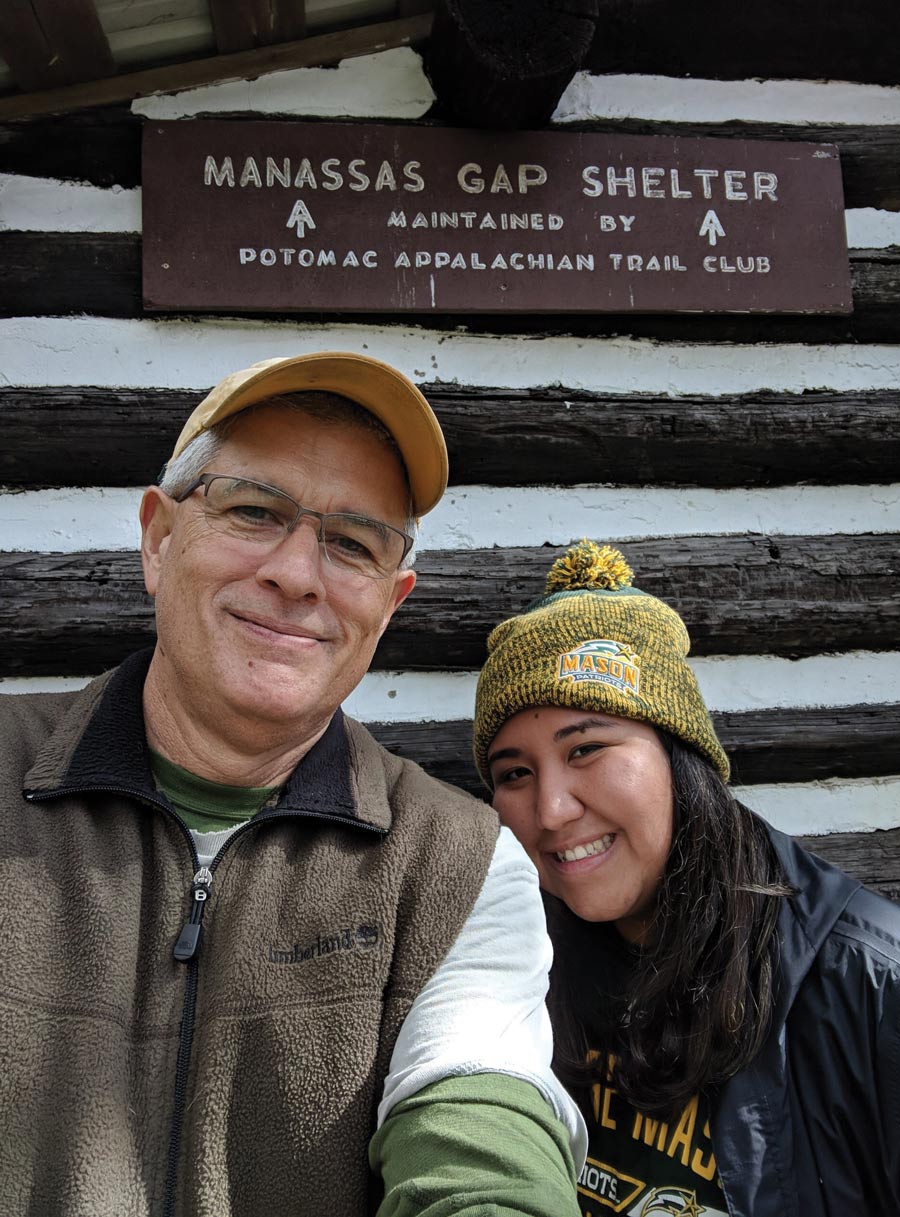



My relationship with the Trail began at an early age and has only grown over time. As a high school student in Virginia, I used to hike the A.T. from Snickers Gap up to the rocky outcropping at Bears Den to watch the sun set. When I was 16, I hiked the White Mountains in New Hampshire with my 71-year-old grandpa, Clint Jones, and I was hooked. He had hiked with his family, my young dad included, up and over those rocky peaks for decades. Ten years after we summited Mount Washington together, in 2008, I thru-hiked to Maine and ten years after that, in 2018, I re-hiked the Trail again in sections for my book documenting all of the A.T. shelters. My Grandpa introduced me to the Trail and it changed not only how I recreated outside, but it also shaped my creative work over the last decade. Feeling connected to the Trail, for me, is a core part of my life and has manifested so many opportunities beyond recreation.
For people of all ages, experience, and backgrounds, the A.T. represents a place to enjoy the outdoors and recreate, but it is and can do so much more for its visitors. The broad and infinitely engaging activity of recreation encompasses volunteerism, stewardship, advocacy, creativity, and history. These experiences can lead to a more lasting and deeper impact for many who take those first steps. Recreation is just the beginning of the greater relationship to the Trail.
When we talk about recreating on the A.T., how do we go beyond the instinctual “walk in the woods”? The Trail is not just an opportunity to get boots on a path, but a place to be inspired and a chance to give back. This love of the Trail has helped thousands of people to experience its benefits — and each year, many of those people volunteer and work to preserve and protect it.


Thousands have dedicated their adult lives and countless hours to the Trail’s maintenance, conservation, and preservation over the years. More than 200,000 volunteer hours are typically recorded each year and more than 6,000 people of all ages and backgrounds are essential to keeping the A.T. vision alive by building, repairing, restoring, clearing and reshaping the Trail. The keepers of the Trail take on many names: boundary monitor, caretaker, “croo,” club member, grant writer, educator, Leave No Trace educator, overseer, ranger, sawyer, section maintainer, shelter adopter, shelter maintainer, Trail crew, Trail club volunteer, Trail maintainer, Trail ambassador, youth leader, and more. The Trail was built and continues to be maintained by ordinary people. These workers and volunteers are the heart and soul of our beloved footpath.
The success and longevity of the A.T. relies on the shared love and commitment of these dedicated people who work to preserve it. For the Finneys in Pennsylvania, maintaining two shelters has become a family affair. George, Curt, and Tawnya Finney and their family have been caretakers for the Tumbling Run shelters in Pennsylvania since 1991. George and Curt joined the Appalachian Trail Conservancy (ATC) and Potomac A.T. Club (PATC) in 1989 and jumped at the opportunity to take care of the Trail so close to home. They maintain one of the few double shelter sites on the A.T. Popular in the southern part of the Pennsylvania — one shelter is “designated” for snoring hikers and the other non-snoring. George, Curt’s father, usually heads out every morning during peak season to make sure that the privy is stocked with toilet paper, hand sanitizer, and is clean. His son and daughter in law, Curt and Tawnya Finney, also live nearby and visit the Trail and shelters almost every day. “We’re in our 50s and are some of the youngest members of the north chapter of the PATC,” says Curt. “The level of dedication and stamina of many of our senior volunteers always amazes us. Many of the volunteers are in their upper 60s, 70s, and even 80s (including George who is 84).”

Beyond on-the-ground maintenance, there are many people who are motivated to protect this special realm through landscape conservation and continue to advocate for the Trail’s protection on a larger scale. The A.T. continues to enhance the A.T. hiking experience and protect thousands of acres of high-priority land. The calling to protect the surrounding flora, fauna, air, and water is made possible by countless people who love and advocate for the Trail. Anne Sentz, ATC’s Landscape Partnership manager, initially came to the Trail as a way to destress from grad school, which turned into a thru-hike and then a career. “The Trail saved my life in so many ways, and it continues to give me a sense of purpose now,” she says. “Ironically, I connect on a deeper level to the A.T. because of its natural values and its potential as a climate corridor in the eastern U.S. Recreation is almost an afterthought for me now.”

For some, the Trail’s inspiration can evolve in the form of a business or lifestyle when they are not hiking it. I know many people who have gone on to hike other long-distance trails, even become “Triple Crowners,” and build careers and businesses that support the Trail in addition to supporting themselves and their families. From shuttle drivers and hostel owners to gear designers, podcasters and outdoor bloggers, this connection comes in many forms.
Wayne Crosby, owner of Bluff Mountain Outfitters in Hot Springs, started his A.T. adventure in 1987. When he arrived in the little Trail town in North Carolina, he fell in love with the area and never left. He has been running his gear shop, raising his family, and supporting hikers on the Trail since ’97, and it has become a Hot Springs (and Trail) institution. Beyond providing gear, shuttles, and experienced knowledge to help hikers on their way, Crosby was part of the broader fight to save one of the areas highest peaks, Bluff Mountain. The A.T. crosses right over its wooded summit before heading down into town and in 1997 a coalition of groups came together to save it from a massive timber project.


The Trail can also be inspirational to artists, writers and historians. Evans Prater is one such creative who thru-hiked the A.T. in 2014, after traveling and exploring as a nomad for years. Being on the Trail changed his whole life’s trajectory. “That experience by far had the most profound, paradigm-shifting effect on me of all my adventures,” he says. After the Trail, he wanted to share his messages of sustainability, preservation, protection, and conservation with the world too and in turn, created a successful business. In 2015, he created his graphics-based sustainable apparel company, Mount Inspiration, with the goal of using only organic and recycled products to spread messages of light, love, hope, and positivity — all with a focus on the great outdoors. Mount Inspiration’s apparel leans on this positivity for outdoor enthusiasts and nature lovers by using soy-based inks and cleaners for their printing process, and utilizes fair-trade, living-wage-certified organic and recycled materials in every product they make. His company continues to give back and they donate a portion of their sales to environmental non-profits with the approach of creating designs that speak to “appreciating the healing and transformative powers of time spent in nature, and respecting and protecting the natural world so all can experience its power.” The company has two retail stores in downtown Asheville, North Carolina, and has its products in over 200 retailers in the U.S., Canada, and the British Virgin Islands.

Mills Kelly, a history professor at George Mason University and PATC member, has dedicated countless hours to researching the many histories of the Trail, involving students in the Department of History and Art History and the greater community for his digital public history project, appalachiantrailhistories.org. Kelly, who continues to section hike the Trail and maintains the Manassas Gap Shelter in Virginia, has visited almost every Trail club archive on the East Coast. His research has brought him to the kitchen tables of some of the great Trail icons to lesser known folks who have oral stories to pass on and be recorded.
“One of the great joys of the research I’ve done over the past four years has been having the opportunity to sit and talk with people who were part of the Trail’s earliest history,” says Kelly. “The oldest of them all, Dorothy Shiflett, is now 103, and her father, Shirley Cole, helped lay out the route of the Trail in southwestern Virginia in 1930. She remembers doing Trail work with him when she was a little girl.” Kelly has also overseen the creation of an extensive historical database and over 25 student-created exhibits, ranging from topics like Hiker Fashion, Invasive Plants and Convenient Hardships: Stereotypes on the Mountain, drawing on the research they have done in his courses on the history of the Trail. He is currently working on a book about the “Lost Appalachian Trail,” that researches the major reroute of hundreds of miles in Virginia in the 1950s that eventually took the Trail over the famous McAfee Knob and Tinker Cliffs.
The A.T. is one of the greatest conservation and recreation success stories in American history. It is a collective and coordinated feat of planning, preserving, and maintaining. It combines recreation, conservation, volunteerism, and an extensive Trail community that encompasses all ages and backgrounds. Whether you spend an hour or months on the Trail or if you visit it every few years or every day, we all have different reasons to be out among the blazes and to reap in its endless benefits and opportunities. May the next 100 years be a testament to the ultimate human-powered experience; a gateway to recreation and beyond.